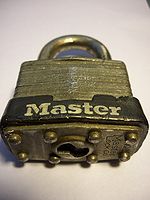Master Lock No 1: Difference between revisions
Oaklandishh (talk | contribs) No edit summary |
(Cleanup) |
||
| Line 4: | Line 4: | ||
| name = Master Lock No. 1 | | name = Master Lock No. 1 | ||
| Img = File:Mastercommercial.JPG | | Img = File:Mastercommercial.JPG | ||
| Img_size = 150px | |||
| maker = [[Master Lock]] | | maker = [[Master Lock]] | ||
| lock_type = [[Padlock]], [[Cylinder]] | | lock_type = [[Padlock]], [[Cylinder]] | ||
| Line 12: | Line 13: | ||
}} | }} | ||
The '''No. 1''' is a [[pin-tumbler]] [[padlock]] made by [[Master Lock]]. The No. 1 uses a laminated padlock body with an internal key-in-knob [[cylinder]]. The inner cylinder uses four pin stacks and does not use any [[security pin]]s. The No. 1 is one of the most common low security padlocks used in the United States. | The '''No. 1''' is a [[pin-tumbler]] [[padlock]] made by [[Master Lock]]. The No. 1 uses a laminated padlock body with an internal key-in-knob [[cylinder]]. The inner cylinder uses four pin stacks and does not use any [[security pin]]s. | ||
The No. 1 is one of the most common low security padlocks used in the United States. | |||
__TOC__ | __TOC__ | ||
| Line 18: | Line 21: | ||
== Principles of operation == | == Principles of operation == | ||
The | The No. 1 cylinder is a [[pin-tumbler]] lock with four pin stacks and no [[security pin]]s. The cylinder typically uses the [[M1]] [[Key#Types_of_Keys|key profile]] but may use other profiles, as well. The standard No. 1 can be opened in both directions but the "commercial" series body restricts opening to clockwise rotation. The No. 1 is not a [[key retaining]] padlock. | ||
The | |||
== Disassembly instructions == | == Disassembly instructions == | ||
The No. 1 cannot be disassembled non-destructively. To disassemble it | The No. 1 cannot be disassembled non-destructively. To disassemble it the rivets that hold the laminated body together must be removed and each layer removed individually. The inner cylinder itself can be disassembled in the same manner as a traditional pin-tumbler lock: | ||
{{Pin-tumbler standard disassembly}} | {{Pin-tumbler standard disassembly}} | ||
Revision as of 17:33, 18 August 2010
Master Lock No. 1
| Master Lock No. 1 | |
 | |
| Name | Master Lock No. 1 |
|---|---|
| Manufacturer | Master Lock |
| Lock Type | Padlock, Cylinder |
| Lock Design | Pin-tumbler |
The No. 1 is a pin-tumbler padlock made by Master Lock. The No. 1 uses a laminated padlock body with an internal key-in-knob cylinder. The inner cylinder uses four pin stacks and does not use any security pins.
The No. 1 is one of the most common low security padlocks used in the United States.
Principles of operation
The No. 1 cylinder is a pin-tumbler lock with four pin stacks and no security pins. The cylinder typically uses the M1 key profile but may use other profiles, as well. The standard No. 1 can be opened in both directions but the "commercial" series body restricts opening to clockwise rotation. The No. 1 is not a key retaining padlock.
Disassembly instructions
The No. 1 cannot be disassembled non-destructively. To disassemble it the rivets that hold the laminated body together must be removed and each layer removed individually. The inner cylinder itself can be disassembled in the same manner as a traditional pin-tumbler lock:
- Remove the cam or C-clip.
- Insert the key and turn the plug 45-90 degrees.
- Withdraw the plug from the cylinder. (A plug follower is recommended)
OR
- Remove the chamber casings and take out each pin-stack individually
- Remove the cam or C-clip.
- Withdraw the plug from the cylinder.
Notes
- The No. 1 cylinder requires a small diameter plug follower.
Vulnerabilities
The No. 1 is vulnerable to a wide range of attacks. The reduced pin tumbler count and poor manufacturing tolerances makes it an easy lock to pick. It's commonly given to locksport beginners as a "confidence lock"; a lock that is easy to open and inspires you to continue picking. The No. 1 may be vulnerable to one or more of the following:
